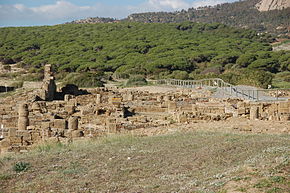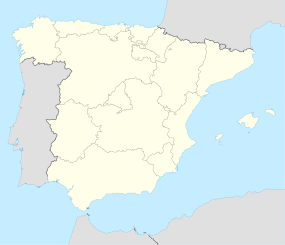Baelo Claudia

The ruins of Baelo Claudia lie along the beach of Bolonia.
|
|
| Location | Bolonia, Province of Cádiz, Andalusia, Spain |
|---|---|
| Coordinates | 36°05′23″N 05°46′29″W / 36.08972°N 5.77472°WCoordinates: 36°05′23″N 05°46′29″W / 36.08972°N 5.77472°W |
| Type | Settlement |
| History | |
| Founded | End of the 2nd century BC |
| Abandoned | 6th century AD |
Baelo Claudia is the name of an ancient Roman town, located 22 kilometres (14 mi) outside of Tarifa, near the village of Bolonia, in southern Spain. Lying on the shores of the Strait of Gibraltar, the town was originally a fishing village and trade link when it was settled some 2,000 years ago. Although prosperous at the time of Emperor Claudius, it went into a decline hastened by earthquakes and was abandoned by the 6th century.
Baelo Claudia is situated on the northern shore of the Strait of Gibraltar. The town was founded in the end of the 2nd century BC as a result of trade with North Africa (it was a major port for Tangier, in Mauretania Tingitana, for example). It is possible that Baelo Claudia had some functions of governmental administration, but tuna fishing, salting, and the production of garum were the primary sources of wealth. The city was eventually successful enough to be granted the title of municipium by Emperor Claudius.
The life of the inhabitants reached its greatest splendor during the 1st century BC and the 2nd century AD. In the middle of the 2nd century, however, the town declined, probably as a result of a major earthquake which wiped out a large part. In addition to such natural disasters, by the 3rd century, the town was beset by hordes of pirates, both Germanic and Barbary. Although it experienced a slight renaissance later in the century, by the 6th century, the town had been abandoned.
Excavations have revealed the most comprehensive remains of a Roman town in the whole of the Iberian Peninsula, with extremely interesting monuments such as the basilica, theatre, market, and the temple of Isis. The spectacular setting in El Estrecho Natural Park allows the visitor to see the coast of Morocco. A modern Visitor Centre showcases many artefacts and has a comprehensive introduction to the site. It also offers parking, shade, toilets, a shop and good views of the sea. Admission is free to citizens of the European Economic Area on production of an ID card.
...
Wikipedia

